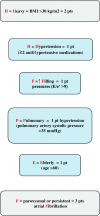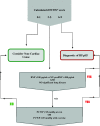Heart Failure with Preserved Ejection Fraction-a Concise Review
- PMID: 32648130
- PMCID: PMC7347676
- DOI: 10.1007/s11886-020-01349-3
Heart Failure with Preserved Ejection Fraction-a Concise Review
Abstract
Purpose of review: Heart failure with preserved ejection fraction (HFpEF) is a relatively new disease entity used in medical terminology; however, both the number of patients and its clinical significance are growing. HFpEF used to be seen as a mild condition; however, the symptoms and quality of life of the patients are comparable to those with reduced ejection fraction. The disease is much more complex than previously thought. In this article, information surrounding the etiology, diagnosis, prognosis, and possible therapeutic options of HFpEF are reviewed and summarized.
Recent findings: It has recently been proposed that heart failure (HF) is rather a heterogeneous syndrome with a spectrum of overlapping and distinct characteristics. HFpEF itself can be distilled into different phenotypes based on the underlying biology. The etiological factors of HFpEF are unclear; however, systemic low-grade inflammation and microvascular damage as a consequence of comorbidities associated with endothelial dysfunction, oxidative stress, myocardial remodeling, and fibrosis are considered to play a crucial role in the pathogenesis of a disease. The H2FPEF score and the HFpEF nomogram are recently validated highly sensitive tools employed for risk assessment of subclinical heart failure. Despite numerous studies, there is still no evidence-based pharmacotherapy for HFpEF and the mortality and morbidity associated with HFpEF remain high. A better understanding of the etiological factors, the impact of comorbidities, the phenotypes of the disease, and implementation of machine learning algorithms may play a key role in the development of future therapeutic strategies.
Keywords: Diastolic dysfunction; HFpEF; Heart failure; Heart failure with preserved ejection fraction; Preserved left ventricular function.
Conflict of interest statement
The authors declare that they have no conflict of interest.
Figures
References
-
- Ponikowski P, Voors AA, Anker SD, Bueno H, Cleland JGF, Coats AJS, Falk V, González-Juanatey JR, Harjola VP, Jankowska EA, Jessup M, Linde C, Nihoyannopoulos P, Parissis JT, Pieske B, Riley JP, Rosano GMC, Ruilope LM, Ruschitzka F, Rutten FH, van der Meer P, ESC Scientific Document Group 2016 ESC Guidelines for the diagnosis and treatment of acute and chronic heart failure: The Task Force for the diagnosis and treatment of acute and chronic heart failure of the European Society of Cardiology (ESC)Developed with the special contribution of the Heart Failure Association (HFA) of the ESC. Eur Heart J. 2016;37:2129–2200. doi: 10.1093/eurheartj/ehw128. - DOI - PubMed
-
- Webb J, Fovargue L, Tøndel K, Porter B, Sieniewicz B, Gould J, Rinaldi CA, Ismail T, Chiribiri A, Carr-White G. The emerging role of cardiac magnetic resonance imaging in the evaluation of patients with HFpEF. Current Heart Failure Reports. 2018;15:1–9. doi: 10.1007/s11897-018-0372-1. - DOI - PMC - PubMed
Publication types
MeSH terms
LinkOut - more resources
Full Text Sources
Medical
Research Materials
Miscellaneous



